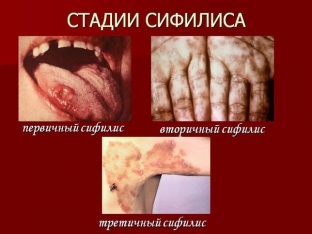Syphilis is one of the most formidable and, unfortunately, common sexually transmitted diseases. The danger of syphilis for others, including medical workers, is that this disease has an undulating course and often latent forms, when the infection can only be detected during random physical examinations or laboratory tests. However, it is very important to assume that the patient has symptoms of syphilis based on a number of specific signs and to start treatment in a timely manner.
Syphilis - first signs
Infection with syphilis mainly occurs through direct contact of a healthy person with a sick person and much less often through indirect contact. The main form of direct contact is sexual. Extrasexual contact infection occurs mainly with kisses, bites. It is necessary to emphasize the possibility of direct infection of medical personnel. Treponema can enter the body even through the smallest damage to the epidermis, imperceptible to the eye, or through a macerated mucous membrane.
The incubation period for syphilis is approximately 3-4 weeks. Sometimes it can be shortened to 15-10 or even 8 days, or, most often, extended to 2-3 months or more. With the appearance of a hard chancre, the incubation period ends and the primary stage of the disease begins.
Features of the course of primary syphilis
The primary period of syphilis lasts 6-8 weeks. During this period, spirochetes continue to multiply intensively and spread in the body. The first external signs of their spread occur at the end of the first week after the appearance of the primary affect (chancre); at the same time regional lymph nodes increase. Lymphadenitis due to its inherent density is called scleradenitis. At first, one-sided, and before the end of the second week, bilateral lymphadenitis occurs.
The duration of the presence of a chancre from the moment of its occurrence until its disappearance depends on many conditions: erosive or ulcerative form, size, depth of the lesion, the presence or absence of a secondary infection, etc. often hard chancre disappears only in the secondary period. In the third, less often the fourth week after the appearance of the chancre, the patient experiences reactive changes. First of all, in the blood (positive serological tests of Wasserman and sedimentary). This circumstance gives grounds for dividing the primary period of syphilis into primary seronegative and primary seropositive.
At 5-6 weeks, there is a gradual increase in all available palpation of the lymph nodes (polyadenitis).
Until the end of the primary period of syphilis, on average 6 weeks after the onset of primary syphiloma, most patients show general symptoms: malaise, loss of appetite, fatigue, headache, pain in the bones and joints, fever, pain in the back of the head due to irritation of the meninges, gastroenteritis and jaundice sometimes develop.
Signs and course of secondary syphilis
If untreated, patients with syphilis 6-8 weeks after the onset of hard chancre develop symptoms of the secondary period - multiple rashes on the skin and mucous membranes, polyadenitis and positive serological reactions. If the patient is not treated, then the secondary period of syphilis can last 2-4 years. The course of syphilis in the secondary period is characterized by undulating states: polymorphic rashes disappear after a few weeks; for some time there are no manifestations of the disease; then comes a recurrence of rashes that already have their own characteristics; after some time, the rashes disappear on their own.
Tertiary syphilis
The tertiary period of syphilis mainly manifests itself after the latent course of the disease of one or another duration, that is, after a certain period of time after the last recurrence of the secondary period. The duration of the latent period in some cases is 2-3 years, in others - 5-10 or more. Manifestations of tertiary syphilis can be observed even earlier.

Latent forms and undulating course of syphilis
The most dangerous source of infection are patients with primary and secondary active manifestations of syphilis on the skin and mucous membranes. It is believed that the saliva of a patient with syphilis contains pale treponema and is contagious only when the patient has specific lesions of the mucous membranes of the oral cavity. However, there are reports in the literature that in some cases treponemas can mix with saliva, penetrating into the oral cavity through normal mucous membranes in the absence of visible specific lesions.
Mostly the features of the development of syphilis are reduced to a wave-like course due to a change in the active manifestations of the disease, periods of a latent state of different duration and a gradual, prolonged change in the clinical and pathological nature of the lesions, which, with the development of the disease, become more pronounced and severe.
During the course of syphilis, it is customary to distinguish between the following periods: incubation, primary, secondary, tertiary, or gummous.
Latent syphilis is divided into early latent (duration no more than 2 years after infection) in persons who are examined as partners of a patient with an infectious form, or detected during wassermanization, and late latent, which is accidentally detected in seroreactions, especially in women due to with miscarriages and stillbirths.
It should be noted that in some cases (at present quite often) the manifestations of syphilis are so inexpressive or hardly noticeable that patients do not know about their disease for many years; the disease is detected in them only during the examination.






Add a comment